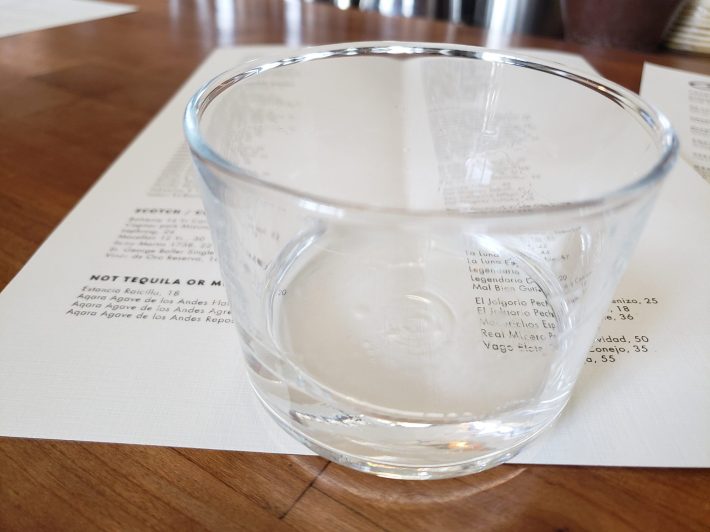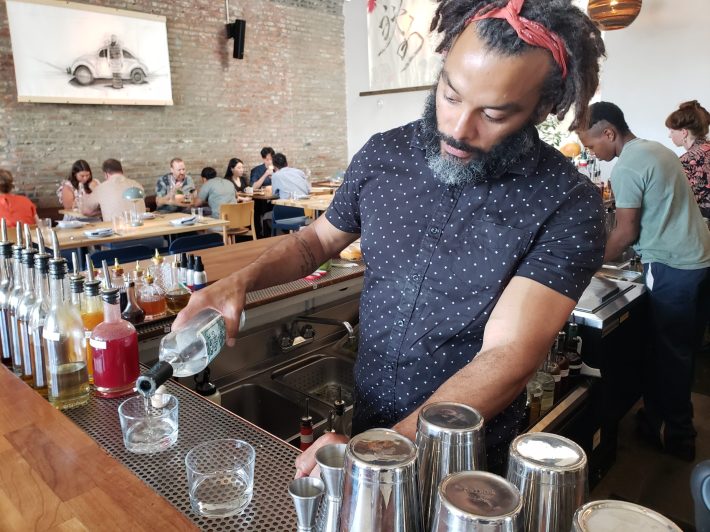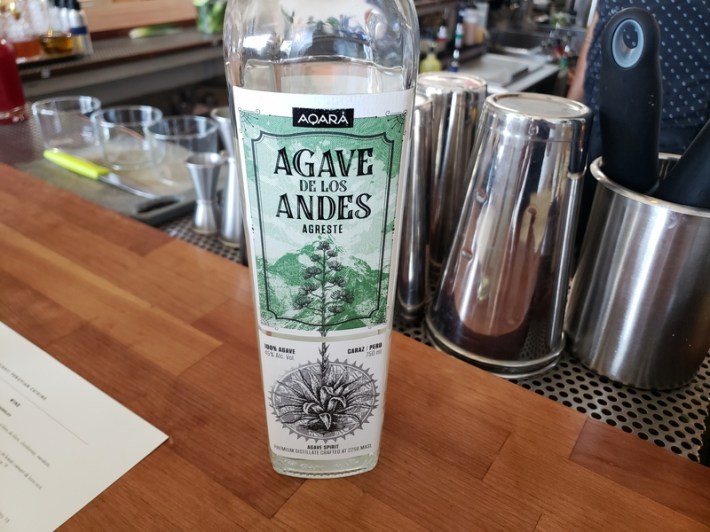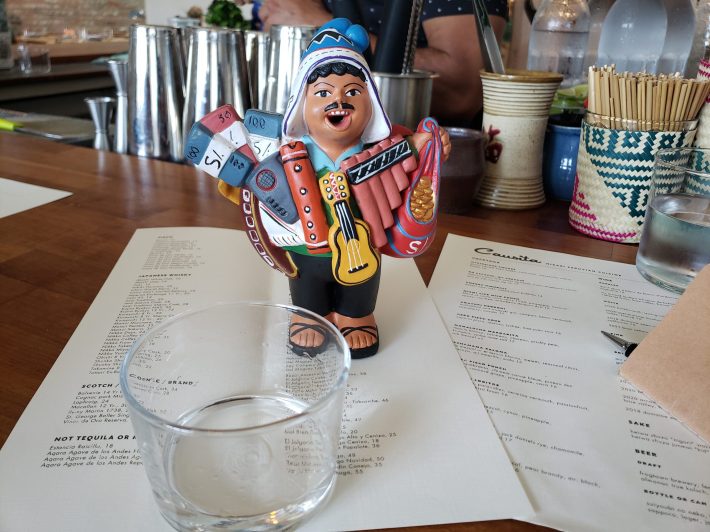While spirits conglomerates and white celebrity venture capitalists scramble over each other to profit from the “next mezcal,” Peru is firing its first fusillade in the maguey wars with a distillate made from agave cordillerensis and A. americana expansa grown in the central highlands of the Andes.
And you can dip your bill into three varieties of the spirit at Silver Lake’s Causita, a buzzing new Nikkei Peruvian restaurant opened at the end of last year by Ricardo Zarate, the Lima-raised L.A. chef so often responsible for introducing Angelenos to dynamic new flavors and aspects of Peruvian food and culture in the past.

Causita’s bar program includes a mighty list of Japanese whiskies and well over 40 mezcales, in addition to creative cocktails using bases like Pisco, Japanese gin, and barley shochu. It’s in a tiny section called “Not Tequila Or Mezcal” that the words Aqará Agave de los Andes, first leap out at us, introducing a Peruvian agave spirit produced by a company named Chopin S.A.C., in conjunction with the Peruvian non-profit Universidad Nacional Agraria La Molina.
The Aqará website doesn’t contain a ton of backstory, though according to the Mezcalitas website, the brand was created by one Marco Suarez, who comes from the agave-rich Andean Highlands region of Caraz, Peru, a name that, according to Aqará’s website, derives from the Quechua word “qaaray,” meaning “land of the agaves.”
The journey to creating Aqará from local agave supposedly took many years, including laborious R&D in the form of studying with German distillers, leading the brand to use copper stills, as well as French yeast experts, and distillation workshops at New York’s Cornell University.
Upon entering Causita at opening time to check these suckers out ourselves, Zarate was the first person L.A. TACO ran into, standing at the door saying hi to his guests. He told us that he’d never really seen Peruvian agave spirits while growing up, a testament to the product’s novelty, though it’s possible ingenious indigenous cultures in this land were making numerous products, including spirits, from agaves for time immemorial.
Zarate noted how agaves are abundant from the U.S. Southwest all the way down through South America, and though no one outside of Mexico can technically label it mezcal, there are even agave spirits being made in California. Given the explosion of global sales in mezcal and Tequila in the last five years, it should come as no surprise that distillers as far as India are finding ways to make their own regional versions of the spirit.
We bellied up to Causita’s small and bumping bar to have a taste of Peru’s efforts. Aqará is not the only Peruvian “mezcal” in existence, but seemingly the first and only one to be exported to the States.

As sounds from Jamaica skipped their crooked beats around us, bartender Adam Fox, a former East Coast prosecutor turned anti-gun violence activist in California, poured a few fingers of the clear spirits as we chatted.
Aqará is available in three of its five forms at Causita. There’s an unaged, stainless steel-kept Plateado (silvered), a four-month, oak-rested reposado, and Agreste, denoting the use of wild agaves. Each spirit is a half-and-half blend of agave cordillerensis and A. americana expansa, hand-picked, way, way up at 7,200 feet above sea level. The agaves are said to be watered by the same rains and glacier melt that fill the Andes’ turquoise-toned Lagoon Paron and hand-chopped using jimas, while the distillery itself is located at a staggering 13707 feet above sea level.

We stuck to the Plateado and Agreste, intent on tasting the agave spirits at their purest.
The Plateado has immediate notes of tropical fruit on its nose, with a notable concentration of passion fruit. It was fruity and bright on the palate, with a base note reminiscent of peach, with reverberations of light citrus, lemon peel, and a little grapefruit.

The Agreste is insistently fragrant, with grassy, floral notes; a bit more herbaceous in the maw, lightly evergreen with slight suggestions of anise. It sweetened with every sip, the texture buttery, and the flavor clean, unwavering, with a sustained finish. The agaves are cooked in mash tuns, steamed, and double distilled, which leads to an absence of any smoke newer agave adherents might expect. The Plateado comes in at 40% ABV and the Agreste at 45% ABV, making them markedly less macho than most mezcales artesanales.
Eventually, our palates and minds meld over a striking sweet, rounded, purple fruit element resembling a grape brandy. Or, in other words… a Pisco(!!), the grape brandy crucial to Peru and Chile. Whether this is done for Peruvian or foreign palates or comes straight outta the Andean terroir, we don’t know. But we suspect it is an intentional result of the copper stills or yeast being used.
"I'd really encourage people to come in and try Aqará because it is truly on the cutting edge of the agave movement," Fox says. "Everyone thinks they love mezcal and love ordering cocktails with it in them, stripping the spirit of the intention and complexity intended. I'm guessing that for most people, their experience with mezcal and tequila is ordering something at a bar and getting something mass-produced put in front of them, a long way away from what the original purveyors intended."

We enjoy sipping these drams and can certainly see ourselves returning for another taste of Aqará, either here or at home. Even if, in their infancy, these Peruvian agave distillates aren’t likely to replace the crazily varied, meticulously cared-for, and essential spirits that come from Mexico’s hundreds of species of agaves, we are always thankful for the chance to further dive into different forms of agave by like-minded obsessives.
Aqará is yet another example of one more intriguing taste from South America offered by L.A.’s premier Peruvian chef, who has introduced our city to the Amazonian river fish, paiche, beef heart anticucho, culito de pollo, and alpaca meat in the past, in addition to the kickass ceviches and lomo saltados we’ve come to expect.
"Two priorities stood out to me as I was learning about our program," Fox says. "Ensuring that the products we had on our shelves were created responsibly, with the benefits going back to the producers' communities, and opening doors for guests to discover and experience things they hadn't before walking into Causita. Aqará aligns perfectly with those two priorities."
Causita ~ 3709 Sunset Blvd. Los Angeles, California 90026







